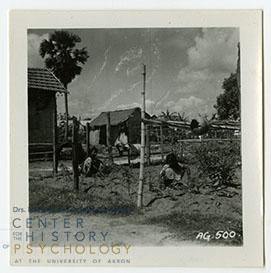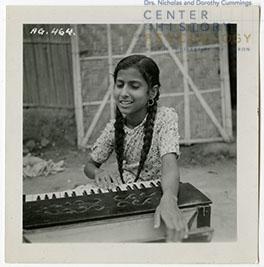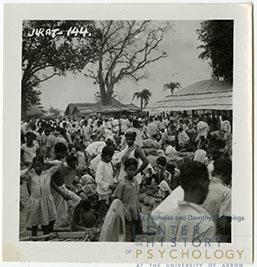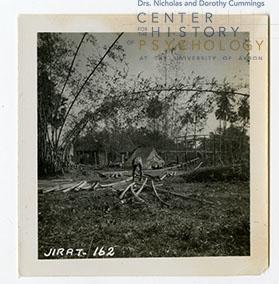– contributed by Museums & Archives Certificate Program student Katie Gable
In 1950, married pair of American psychologists Gardner and Lois B. Murphy went to India to help solve social tensions between Hindus and Muslims. Using funds allocated to them by UNESCO, they assembled six teams of researchers who were headed by Indian psychologists, professors, anthropologists, and more. Each team used informal interviews to gather research on the cause and effect of the tensions and Gardner Murphy used this research to write In the minds of men: The study of human behavior and social tensions in India.
In my previous blog post, I explained that the Murphy’s went to work in India for UNESCO following decolonization with the goal of rectifying social tensions between Hindus and Muslims. While that is technically true, it is a bit of an oversimplification of the state of India at that time. To better understand the work Gardner and his teams did, we must better understand India’s history of colonization of decolonization.
The Indian Partition is one of the most heartbreaking events in the country’s history. When Great Britain relinquished control of the subcontinent in 1947, the celebration of independence was quickly overshadowed by the horror of partition. Great Britain relied on the “divide rule” to cause conflict between the major religions in India in order to gain power. So concerns over a civil war post decolonization led the British government to haphazardly “solve” the problem before officially leaving. Knowing religious tensions would be the number one cause of war, they decided to divide the land into a Muslim majority country– Pakistan, and a Hindu majority country– India. Relying on outdated census maps, law lord Cyril Radcliffe carved out these borders. These borders were kept secret until Britain officially left the country leaving their former subjects to navigate these new borders.
The Indian partition resulted in the uprooting, devastation, and death of many people. If you were of the wrong religion living in the wrong place, you were forced to flee. The road for both Muslims and Hindus on their way to the correct side of the border resulted in 1 to 2 million deaths from starvation, disease, or religious violence. It also resulted in tons of refugees who received little support from the government (TRT World, 2020).
The UNESCO study was about more than just social tensions between different religions; it was meant to examine and resolve the social and religious upheaval created by Great Britain. Gardner and his teams set out to understand not just the tensions between Muslims and Hindus, but also the trauma of being displaced and separated at the hands of a government that provided no help to those forced to live under the new partition.
When I began going through the still images in the Gardner and Lois B. Murphy papers I came across multiple folders with photographs labeled “India” and “UNESCO”, but initially decided they were not useful as they appeared to be random photos from random villages that did not include the names or pictures of researchers I decided to highlight. However, following my research on the Indian Partition, these photographs became exceedingly important. They were from the sixth UNESCO study, B.S. Guha’s anthropological and psychological look at the plight of refugees from Pakistan.
Guha, an anthropologist, was the first Indian to receive a Ph.D. from Harvard and established the anthropology department at the University of Calcutta (Sarkar, n.d.). During the Murphy’s research period in India, B.S. Guha was serving as the director of the first anthropological survey of India, so he was very interested in examining refugees and their camps. Guha wanted to understand how their existence factored into the tensions between Muslims and Hindus.
The camps we have photos of are Jirat and Azadgarh and both refugee camps filled with Hindus from what became Pakistan. Jirat was a camp resettled by the government while Azadgarh was a camp of “self-settlers” or “squatters.” Though both camps were results of similar situations and both lacked help from the government, life and outlook there was very different according to Guha. Jirat refugees were completely destitute and had to build their town from scratch, excavating roads, building houses and more. Azadargah refugees settled where “well-to-do” Muslims had previously lived, moving into the houses and jobs that were left behind. Though the camps of people were both suffering from tension issues, Guha and his team labeled Azadgarh “high-morale” and Jirat “low-morale” (Chatterji, 2007). While both situations are unfortunate, I can understand based on images I found in the Murphy collection why you would label these camps based on morale.
In the Azadgarh folders you can see photos of quality standing structures and even a young girl playing an instrument and smiling.


In the Jirat photos, the camp looks crowded and refugees look exhausted from having to build their own homes, excavate their own roads, and more.


Partition impacted every aspect of life. Even Pars Ram, the star of my previous blog post’s archival mystery, was asked to leave his long-standing position at Lahore University that following decolonization became a part of Muslim majority Pakistan (Murphy, 1953). During a meeting with reference archivist Lizette Barton and executive director of Cummings Center Dr. Cathy Faye, they asked me to try and understand the personal motivations for involvement with this study. While I have yet to find any specifics, I think it is clear that the concern over not just social tensions but understanding and coping with the trauma of partition was of utmost importance to these Indian scholars. This was something they had to live through and then deal with the after effects of. Maybe they were not directly impacted, maybe they were, but they saw what was happening to their country and recognized the urgency to identify and rectify these problems.
References
Chatterji, J. (2007). “Dispersal” and the Failure of Rehabilitation: Refugee Camp-dwellers and Squatters in West Bengal. Modern Asian Studies, 41(5), 995–1032.http://www.jstor.org/stable/4499809
Murphy, G. (1953). Our UNESCO Mission to India. In G. Murphy, In the minds of men: The study of human behavior and social tensions in India (pp. 11–26). Basic Books/Hachette Book Group.https://doi.org/10.1037/11234-002
[TRT World]. (2020, August 14). India-Pakistan partition explained [Video]. Youtube. https://youtu.be/OnTYLyNUPMc
Sarkar, J. (n.d.). Short Biography of Biraja Sankar Guha. Your Article Library. Retrieved May 2, 2023, from https://www.yourarticlelibrary.com/essay/short-biography-of-biraja-sankar-guha/41678
